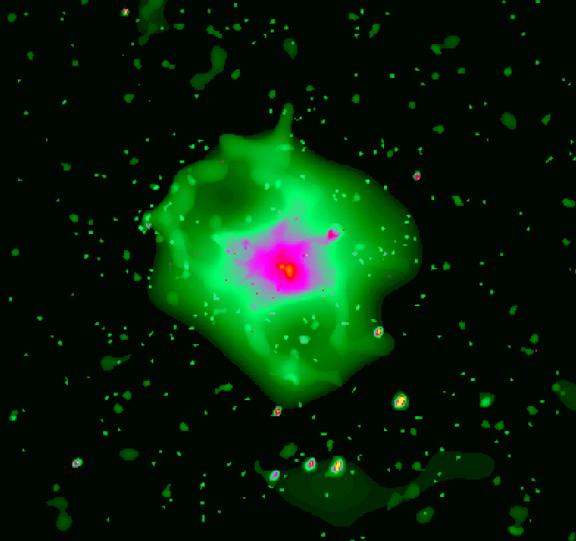
 Credit: NASA/CfA/J.Vrtilek et al.
Credit: NASA/CfA/J.Vrtilek et al.
Cosmic Jet Flameout?
Compact groups of galaxies (association of dozens of gravationally-bound
galaxies) are important cosmic objects since they are thought to be the
building blocks out of which the largest structures in the universe, galaxy
clusters, are built. X-ray imaging of these compact groups are an
important way to probe the mass total mass of the group, since X-ray
imaging reveals the location and amount of hot gas contained by the
combined gravitational field of all the group members. The image above
shows an X-ray image of the Hickson Compact Group 62 (HCG 62) produced by
the ACIS camera
on the CHANDRA X-ray observatory.
This image shows a cloud of diffuse X-ray emitting gas (shown in green in
this false-color image) which brightens considerably towards the center.
The brightest emission is shown in purple/red, with the brightest emission
near an elliptical galaxy known as NGC 4761. Two unusual X-ray faint
bubbles can be seen towards the upper left and lower right of NGC 4761.
These faint bubbles could be produced by absorption of the X-ray emission
by clouds of cold gas between us and the compact group. The symmetrical
placement of the bubbles around NGC 4761 however suggests a real
association with the elliptical galaxy. Astronomers speculate that perhaps
these bubbles represent regions of space evacuated by a symmetrical
galaxy-sized jet emitted from the center of NGC 4761. Such large-scale
jets are seen from other galaxies. However currently no such jet is
associated with NGC 4761. This means that the jet must have turned off
somehow at some time in the distant past if this conjecture is correct. If
true then this is one of the only known cases for such a cosmic jet
"flame-out"!
Last Week *
HEA Dictionary * Archive
* Search HEAPOW
* Education
Each week the HEASARC
brings you new, exciting and beautiful images from X-ray and Gamma ray
astronomy. Check back each week and be sure to check out the HEAPOW archive!
Page Author: Dr. Michael F.
Corcoran
Last modified April 30, 2001


